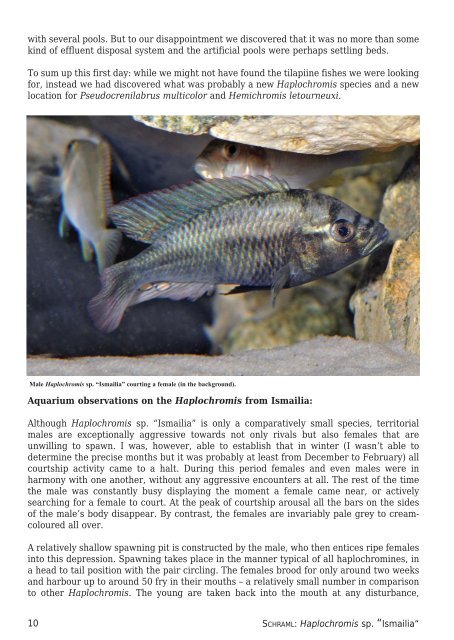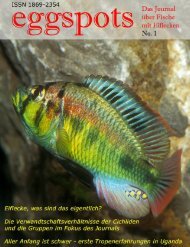Eggspots Elsewhere - Welt der Fische / World of Fishes
Eggspots Elsewhere - Welt der Fische / World of Fishes
Eggspots Elsewhere - Welt der Fische / World of Fishes
You also want an ePaper? Increase the reach of your titles
YUMPU automatically turns print PDFs into web optimized ePapers that Google loves.
with several pools. But to our disappointment we discovered that it was no more than some<br />
kind <strong>of</strong> effluent disposal system and the artificial pools were perhaps settling beds.<br />
To sum up this first day: while we might not have found the tilapiine fishes we were looking<br />
for, instead we had discovered what was probably a new Haplochromis species and a new<br />
location for Pseudocrenilabrus multicolor and Hemichromis letourneuxi.<br />
Male Haplochromis sp. “Ismailia” courting a female (in the background).<br />
Aquarium observations on the Haplochromis from Ismailia:<br />
Although Haplochromis sp. “Ismailia” is only a comparatively small species, territorial<br />
males are exceptionally aggressive towards not only rivals but also females that are<br />
unwilling to spawn. I was, however, able to establish that in winter (I wasn’t able to<br />
determine the precise months but it was probably at least from December to February) all<br />
courtship activity came to a halt. During this period females and even males were in<br />
harmony with one another, without any aggressive encounters at all. The rest <strong>of</strong> the time<br />
the male was constantly busy displaying the moment a female came near, or actively<br />
searching for a female to court. At the peak <strong>of</strong> courtship arousal all the bars on the sides<br />
<strong>of</strong> the male’s body disappear. By contrast, the females are invariably pale grey to creamcoloured<br />
all over.<br />
A relatively shallow spawning pit is constructed by the male, who then entices ripe females<br />
into this depression. Spawning takes place in the manner typical <strong>of</strong> all haplochromines, in<br />
a head to tail position with the pair circling. The females brood for only around two weeks<br />
and harbour up to around 50 fry in their mouths – a relatively small number in comparison<br />
to other Haplochromis. The young are taken back into the mouth at any disturbance,<br />
10<br />
SCHRAML: Haplochromis sp. “Ismailia“




